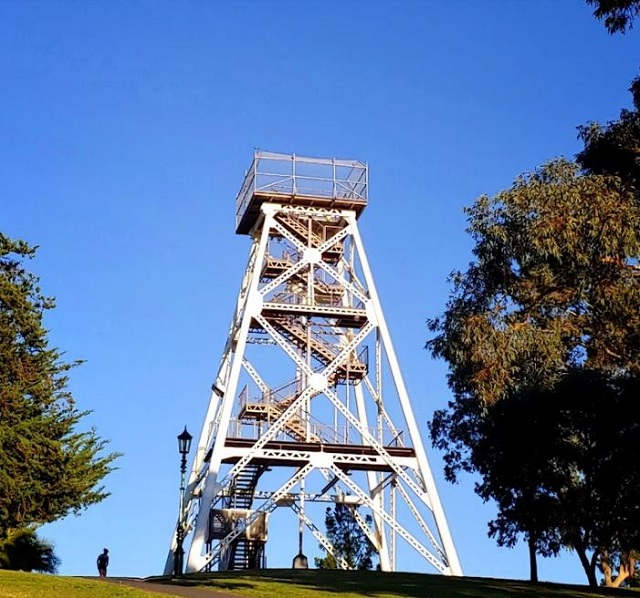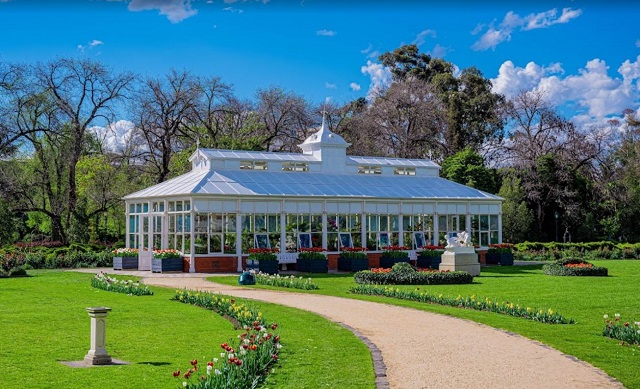Bendigo - Rosalind Park

Located in the centre of town, Rosalind Park is Bendigo's premier park. It is a significant site for its historic trees, buildings, structures and landscapes that are reflective of Bendigo's character. Retreat to its cool green lawns and fernery, walk its avenues, discover historic relics and structures and the displays in the unique conservatory.
The Rosalind Park Precinct covers the entire block from Pall Mall, View Street, Barnard Street and Park Road. The precinct combines a wide variety of spaces and functions including the historic parkland, sporting facilities, schools and the Ulumbarra theatre. The precinct includes two major areas, Rosalind Park Upper featuring the Poppet Head and Queen Victoria Oval and Rosalind Park Lower featuring the heritage gardens and Chinese Precinct.
Attractions
Significant trees and avenues of Rosalind Park
The park is significant for its horticultural heritage. Many trees date back to the 1800s and new ones are planted each year as replacements. Walk the urban forest to see elms, oaks, Queensland kauri and Australian teak, amongst others.
Children's playspace
The Camp Hill Primary School Children's playspace is available to the public outside of school hours.
Lookout Tower

The Poppet Head lookout tower was used during the gold rush to process mine tailings and to hoist flags indicating that mail had arrived. It was moved to this location in 1931 from the Garden Gully United Mine and has become the symbol of Bendigo. Climb it to enjoy the best view in town and see the Bendigo Heritage Mosaic by Maery Gabriel that depicts Bendigo's mining history.
Cascades
The cascades are a reconstructed 19th century water feature. Designed by renowned architect William Vahland and built in 1880, it originally included statues, fountains and a fern grotto. It fell into disrepair during the 20th century and has been partially renovated.
Former Municipal Baths
At the rear of the netball courts lies the former municipal baths, an old water body formed as part of local mining activity that was used for recreational swimming. The water body is currently fenced and undergoing planning for redevelopment.
Queen Victoria Gardens
The Queen Victoria Garden is located on the corner of Pall Mall and View Street. This prominent garden includes a statue of Queen Victoria dating from 1903 and showy floral displays throughout the year.
Annual tulip display
Each autumn, our horticulturists plant thousands of tulip bulbs to create a showy floral display for the community to enjoy in spring.
Fernery
The cool, green, lush fernery provides a shady respite from the heat. Explore its water features, bridges, rockeries, gravel paths and fern and palm collections. Once the site of a billabong on the Bendigo Creek, the fernery features remnant River Red Gums of historical significance. These mature trees provide a canopy of shade for the more tender ferns in the fern collection that includes a great selection of Victorian species.
Conservatory Gardens

The Conservatory Gardens features an ornate 19th century Conservatory building, rose gardens and heritage sculptures. The Conservatory building was erected in 1897 and is the last building of its type in a public park in Victoria. A highlight is the floral and foliage displays that are on show throughout the year, including the spring tulip display.
Lansell Gardens
Located between Sidney Myer Place and the RSL, these gardens are named after George Lansell, who was one of the few people who made his fortune in Bendigo's gold rush. His statue stands in this garden with a rare Chilean Wine Palm.
Yi Yuan Chinese Gardens
Yi Yuan is a walled Chinese Garden that reflects the influence and traditions of the local Chinese community. The design of the walled garden is inspired by the gardens of the Summer Palace in Beijing. It features Chinese-style art, sculpture, water features and horticulture.
Sister Cities Gardens
Bendigo's three sister city relationships are each represented with a garden:
- Los Altos (California, USA) - Dry climate plants from California and surrounding regions have been used.
- Tian Shui (China) - Represented by the Camellia walk next to the fernery.
- Penzance (UK) - A knot garden including clipped serpentine box hedges.
The Bendigo Creek and its bridges are a significant example of late 19th century urban infrastructure using stone masonry techniques. The creek was realigned, widened, lined with flagstones, walled with sandstone and capped with granite. The iron bridges were built in 1882 to replace earlier narrower structures.
Site history
The Bendigo area is the traditional land of the Dja Dja Wurrung people. Prior to 1851, the area we now call Rosalind Park was a grassy woodland with a chain of deep, permanent fresh water ponds lined with large River Red Gums. In 1851, the gold rush transformed the area and eventually the mullock heaps became the most prominent public park in Bendigo. Rosalind Park was added to the Victorian Heritage Register in 2000 for its historic, archaeological, aesthetic, scientific (botanical) and architectural significance to the State of Victoria.
Opening Hours:
Rosalind Park is open all hours. The Children's playground is open to the public only during non-school hours. The Fernery and Conservatory are open from 8am to sunset every day.
Cost:
Free
Location
30 Gaol Road, Bendigo 3550 Map











